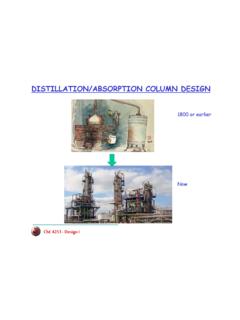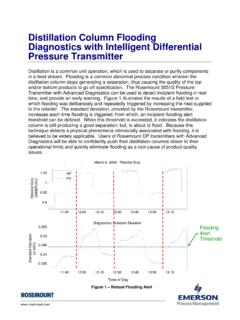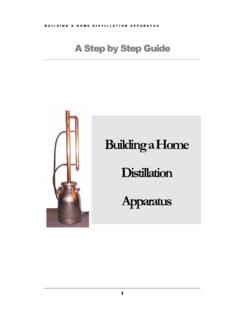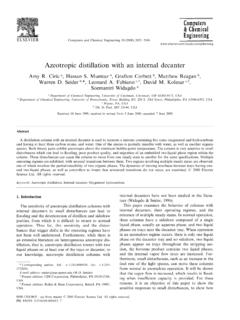Transcription of METHOD 5031 VOLATILE, NONPURGEABLE, …
1 CD-ROM5031 - 1 Revision 0 December 1996 METHOD 5031 volatile , nonpurgeable , water - soluble COMPOUNDS BY AZEOTROPIC AND METHOD describes a procedure for separation of nonpurgeable , water - soluble , andvolatile organic compounds in aqueous samples or leachates from solid matrices using azeotropicdistillation. The appropriate gas chromatographic/mass spectrometric (GC/MS) determinative stepsare found in METHOD 8260. The appropriate gas chromatographic/flame ionization (GC/FID)determinative steps are found in METHOD 8015. This separation METHOD should be used as analternative to METHOD 5030 for compounds that are difficult to purge and trap. METHOD 5031 is usefulin the determination of the following compounds: compound NameCAS alcohol107-18-61-Butanol104-51-8t-Butyl alcohol75-65-0 Crotonaldehyde123-73-91,4-Dioxane123-91- 1 Ethanol64-17-5 Ethyl Acetate141-78-6 Ethylene oxide75-21-8 Isobutyl alcohol78-83-1 Methanol67-56-1 Methyl ethyl ketone78-93-3 Methyl isobutyl ketone108-10-1N-Nitroso-di-n-butylamine9 24-16-3 Paraldehyde123-63-72-Pentanone107-87-92- Picoline109-06-81-Propanol71-23-82-Propa nol67-63-0 Propionitrile107-12-0 Pyridine110-86-1o-Toluidine95-53-4 Chemical Abstract Service Registry compounds may be separated successfully using this METHOD .
2 However, useof this METHOD to detect and measure additional analytes may be done only after the laboratoryobtains acceptable accuracy and precision data for each additional analyte. In general, compoundsthat form a water azeotrope that is greater than 50% analyte, with this azeotrope boiling at less thanCD-ROM5031 - 2 Revision 0 December 1996100EC, can be successfully distilled. The initial study (Reference 5) to determine the ability of thismethod to separate compounds found that the following compounds perform poorly in this METHOD :CompoundCAS 62-53-3 Phenol108-95-2 Dimethylformamide 68-12-2 Propargyl alcohol107-19-72-Ethoxyethanol110-80-5 METHOD detection limits (MDLs) and analyte concentration ranges are listed in theappropriate determinative methods .
3 The MDL for a sample may differ from those listed, dependingon the nature of interferences in the sample METHOD is restricted to use by or under the supervision of analysts experienced inprocedures involving quantitative separation techniques. Each analyst must demonstrate the abilityto generate acceptable results with this OF azeotrope is a liquid mixture of two or more substances which behaves like a singlesubstance, in that it boils at a constant temperature and the vapors released have a constantcomposition. Azeotropic distillation is a technique which uses the ability of selected organiccompounds to form binary azeotropes with water to facilitate the separation of the compounds froma complex technique: One liter of the sample is buffered to pH 7, spiked with thesurrogate spiking solution, and brought to boiling in a 2 L distillation flask.
4 The polar, volatile organiccompounds (VOCs) distill into the distillate chamber for 1 hour, and are retained there (Figure 1).The condensate overflows back into the pot and contacts the rising steam. The VOCs are strippedby the steam and are recycled back into the distillate chamber. Analytes are detected andquantitated by either direct aqueous injection GC/MS or technique: An aliquot (normally 5 g or 40 mL) of sample is azeotropicallydistilled, and the first 100 L to 300 L of distillate are collected. The water soluble volatile organiccompounds are concentrated into the distillate using a microdistillation system. Most semi- and non- volatile interferences remain in the boiling flask.
5 Use of an internal standard is recommended toimprove METHOD precision. Concentration factors are typically one and two orders of magnitude forsoil and water matrices, respectively. The distillation takes five to six minutes. Analytes aredetected and quantitated by either direct aqueous injection GC/MS or interference may be caused by contaminants in solvents, reagents, glasswareand other sample processing hardware that lead to discrete artifacts and/or elevated baselines inthe chromatograms. All of these materials must be routinely demonstrated to be free frominterferences under the conditions of the analysis by running laboratory METHOD must be scrupulously cleaned.
6 Clean all glassware as soon aspossible after use by rinsing with methanol, followed by a distilled water rinse and drying in aCD-ROM5031 - 3 Revision 0 December 1996105EC oven between analyses. Detergent solutions may also be used, but care must be takento remove the detergent residue from the glassware. After drying and cooling, glasswareshould be stored in a clean environment to prevent any accumulation of dust or othercontaminants. Other approaches to cleaning glassware may also be employed, provided thatthe laboratory can demonstrate that they are effective in removing contamination may occur when a sample containing low concentrationsof volatile organic compounds is analyzed immediately after a sample containing highconcentrations.
7 One or more blanks should be run to check for analysis of a sample containing high concentrations of volatile organiccompounds, one or more blanks should be analyzed to check for cross interferences may be caused by contaminants that are in the sample. The extentof matrix interferences will vary considerably from source to source, depending upon the nature anddiversity of the matrix being sampled. If significant interferences occur in subsequent samples,additional cleanup may be AND Macrodistillation bottom flask - 2-L, 14/20 ground-glass joint. column - 20 cm long, 14/20 ground-glass Nielson-Kryger apparatus (Figure 1) - This glassware can be made bya glassblower, or a similar apparatus can be purchased and then modified by a glassbloweraccording to the dimensions given in Figure , submersible pumps - One for each distillation , a water chiller may be used in place of a recirculating submersible pump, withice water , if the chiller can maintain a temperature of 0EC to 5EC in all distillation container - Preferably insulated, holds ice water to maintain glassware - 10-mL class A volumetric flasks and volumetric pipets ofvarious sizes, 1 to 3 vials - 4-dram glass, with polytetrafluoroethylene (PTFE)-linedscrew cap or crimp top Paper - narrow range ( ).
8 MicroVOC System - Shamrock Glass, or bottom flask - 100-mL, 14/20 ground-glass - 4 Revision 0 December column - 14/20 ground-glass joint, cm OD, cm ID,60 cm length (see Figure 2). insulation - polyurethane foam, inch OD, inch ID, 55 cm beads, 5 mm clamps for 14/20 ground-glass reducing union - 14/20 ground-glass joint to 6 mm OD tube (seeFigure 3). steel reducing union - 1/16 inch to 1/4 condenser - PTFE tubing, 1/16 inch OD to 1/32 inch ID (40 cm inlength, or equivalent). stand with rod - 1 mantle - Glas-Col, 115 volts, 230 watts, STM 400, or controller - Glas-Col PL-115-Cordtrol, 115 volts, 600 watts, carbon boiling chips - VWR Catalog No.
9 26397-409, or vials - glass, with PTFE-lined screw cap or top vial inserts, 100- L - The vial may be calibrated by dispensing aknown volume of liquid into it, and marking the side of the - Analytical, capable of weighing - Various chemicals shall be used in all tests. Unless otherwise indicated, it isintended that all reagents shall conform to the specifications of the Committee on AnalyticalReagents of the American Chemical Society, where such specifications are available. Other gradesmay be used, provided it is first ascertained that the reagent is of sufficiently high purity to permit itsuse without lessening the accuracy of the Reagent water - All references to water in this METHOD refer to organic-freereagent water as defined in Chapter phosphate, monobasic, KHPO (macrodistillation technique).
10 24CD-ROM5031 - 5 Revision 0 December phosphate, dibasic, NaHPO (macrodistillation technique). chloride, NaCl (macrodistillation technique). Standard Solutions - Prepared from pure standard materials or from purchasedcertified , in organic-free reagent water , a set of stock standard solutions eachcontaining one of the target analytes. Place about mL of organic-free reagent water in a10 mL tared, ground-glass stoppered volumetric flask. Weigh the flask to the g. Add the assayed reference material, as described - Using a 100- L syringe, immediately add two or more dropsof assayed reference material to the flask using the known density as an approximateguide to place g in the flask.















